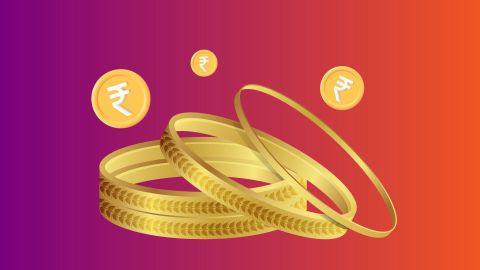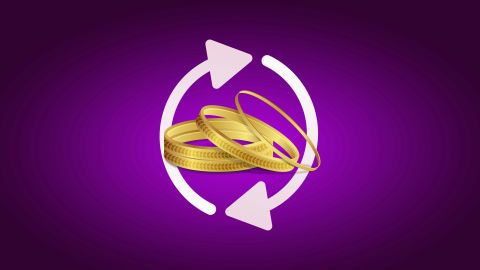Some facts about gold in Kolar
The mines were operational until 2001 when they were closed due to diminishing returns and increasing costs. Despite this, KGF remains an iconic symbol of India's mining heritage. The area is also famous for the beautiful structures and the colonial architecture left behind by the British, making it a place of historical interest. Today, Kolar continues to draw attention for its past glory and potential future exploration possibilities.
24 carat gold price in Kolar
22 carat gold price in Kolar
If you're looking to buy gold in Kolar, understanding the price of 22 carat gold is crucial. The cost of 22 carat gold in Kolar fluctuates based on various factors including market demand and the purity of 22 carat gold. The purity of 22 carat gold is a key aspect to consider, as it directly impacts the price. With 22 carat gold being 91.6% pure, it's a popular choice for jewelry due to its balance of durability and value. To get the most accurate pricing, it's essential to check current market rates and consider any additional costs such as making charges or taxes. Local gold dealers in Kolar can provide real-time updates and detailed information on the price of 22 carat gold, ensuring you make an informed decision based on the latest data.How is the purity of gold evaluated in Kolar?
-

Karat meter
This is a popular electronic device used to measure the purity of gold by analysing its composition.
-

Acid test
A traditional method where different acids are applied to the gold to test its reaction and ascertain its purity level.
-

XRF Spectrometry
A modern, non-destructive technique that uses X-ray fluorescence to determine the metal composition of gold.
-

Touchstone method
Involves rubbing the gold item on a touchstone and using a reference sample to compare the marks.
-

Fire assay
The most accurate method, though less commonly used for consumer checks, involves melting the gold and separating it from impurities.
-

BIS hallmarking
An official mark that certifies the purity of gold, ensuring it meets the standards set by the Bureau of Indian Standards (BIS).
-
Factors that affect gold rate in Kolar
Several factors influence the gold rate in Kolar, reflecting both global and local economic conditions.
- Global gold prices: The international gold market significantly impacts local rates. Prices are influenced by global demand and supply, geopolitical tensions, and economic stability. Changes in the international market are quickly reflected in Kolar’s gold rates.
- Inflation: As a hedge against inflation, gold prices tend to rise when inflation is high. In periods of economic uncertainty, investors prefer gold, driving up its price.
- Currency fluctuations: The value of the Indian Rupee against the US Dollar affects gold prices in Kolar. A weaker Rupee makes gold more expensive, as gold is traded in US Dollars internationally.
- Local demand: During festive seasons and weddings, the demand for gold in Kolar increases, leading to higher prices. Cultural factors and seasonal trends play a significant role in shaping local gold demand.
- Government policies: Import duties, taxes, and regulations on gold imports can affect its price. Changes in these policies can either increase or decrease the cost of gold in Kolar.
- Interest rates: Lower interest rates make borrowing cheaper, encouraging investment in gold. Conversely, higher interest rates can lead to lower gold demand as alternative investments become more attractive.
- Mining activity: Although Kolar Gold Fields have ceased operations, any future exploration or discoveries in the region could impact local gold prices by affecting supply.
Understanding these factors helps in comprehending the dynamics behind gold price fluctuations in Kolar.
Why does the gold rate fluctuate daily in Kolar?
The gold rate in Kolar fluctuates daily due to several factors. Global market trends, including changes in gold prices internationally, directly influence local rates. Currency exchange rates, particularly the value of the Indian Rupee against the US Dollar, also play a crucial role. Additionally, local demand fluctuations, impacted by seasonal and cultural events, affect prices. Economic indicators like inflation and interest rates further contribute to daily variations. Lastly, geopolitical events and changes in government policies regarding gold imports and taxation can cause immediate price shifts, leading to daily fluctuations in Kolar’s gold rate.
What is the best investment option: physical gold, gold ETFs, or sovereign gold bonds in Kolar?
When considering gold investment options, investors typically choose between physical gold, Gold ETFs, and Sovereign Gold Bonds (SGB).
1.Physical Gold: This traditional form of investment includes jewellery, coins, and bars. While tangible and easily accessible, it involves storage and security concerns, along with making charges and purity issues.
2.Gold ETFs: These are traded on stock exchanges and offer the convenience of investing in gold without physical possession. They have lower costs compared to physical gold and provide liquidity, making it easy to buy and sell.
3.Sovereign Gold Bonds (SGB): Issued by the Indian government, Sovereign Gold Bond (SGBs) are a modern alternative. They offer an additional benefit of a sovereign gold bonds interest rate, typically around 2.5% per annum, paid semi-annually. This makes SGBs not only a hedge against inflation but also an income-generating asset. Moreover, they eliminate storage issues and are free from the risks associated with physical gold.
The impact of GST on gold rates in Kolar
The implementation of the Goods and Services Tax (GST) has had a significant impact on gold prices in Kolar. The introduction of a uniform tax structure was aimed at simplifying the tax regime, but it also brought notable changes to the gold market.
Gold GST rates: For 22-carat gold, commonly used in jewellery, the GST rate stands at 3%. This rate is applied to the value of gold as well as the making charges. Similarly, the gold GST rate of 22 carat gold and 24 carat gold GST rate is also set at 3%. Prior to GST, gold attracted various taxes including VAT, excise duty, and customs duty, leading to a cumulative tax burden that was often higher than the current GST rates.
Impact on prices: The standardised 3% GST rate has brought more transparency to gold pricing. However, it has also led to an initial increase in prices as jewellers passed on the tax burden to consumers. Over time, the streamlined tax system has facilitated a more straightforward pricing mechanism, benefiting consumers with clearer price structures.
Market dynamics in Kolar: In Kolar, known for its active gold market, the GST has influenced both consumer behaviour and business operations. Jewellers now operate with greater compliance and fewer tax-related ambiguities. Consumers, on the other hand, have experienced a more predictable and consistent pricing model, although the initial transition phase saw some price adjustments.
Overall, while the GST has added a tax layer to gold purchases, its uniformity and clarity have led to a more regulated and transparent market in Kolar.
What do I need to know when I am buying gold jewellery for the first time in Kolar?
When purchasing gold in Kolar, several key considerations ensure a wise investment:
- Purity and certification: Verify the gold's purity. For jewellery, 22-carat gold is common, while 24-carat is preferred for investment. Ensure the gold is hallmarked by the Bureau of Indian Standards (BIS) for authenticity.
- Market rates: Check current gold rates in Kolar and compare them with other markets. Gold prices fluctuate daily, influenced by global and local factors.
- Making charges: Jewellers often levy making charges, which can vary widely. Negotiate these charges and understand their impact on the overall cost.
- Reputation of the seller: Purchase from reputable jewellers known for fair practices and quality. Customer reviews and recommendations can guide you.
- Buy-back terms: Understand the buy-back policy of the jeweller. Flexible buy-back options can be beneficial if you decide to sell the gold later.
- Storage and insurance: Consider safe storage options and insurance for valuable gold purchases to protect against theft or loss.
Advantages of investing in gold in Kolar
Investing in gold in Kolar offers numerous benefits, making it a popular choice among residents.
- Hedge against inflation: Gold is a reliable hedge against inflation. Its value tends to rise when the cost of living increases, preserving wealth over time.
- Liquidity: Gold is highly liquid, meaning it can be easily bought and sold. This makes it a convenient asset during financial emergencies.
- Cultural significance: In Kolar, gold holds cultural importance, especially during festivals and weddings. Investing in gold jewellery not only serves as an investment but also fulfils cultural and social obligations.
- Portfolio diversification: Including gold in an investment portfolio diversifies risk. Gold often performs well when other asset classes, like stocks, underperform.
- Security: Physical gold, whether in the form of jewellery or coins, provides a sense of security. It is a tangible asset that can be kept safe with proper storage and insurance.
- Capital appreciation: Over the long term, gold tends to appreciate in value, offering potential capital gains to investors.
What is making charges on gold jewellery?
Making charges on gold jewellery refer to the cost associated with the craftsmanship involved in creating the piece. These charges cover the labor and skill required to design, mould, and finish the jewellery. Making charges can vary widely based on the complexity of the design, the type of workmanship, and the jeweller's pricing policies. They are typically added to the gold price per gram and can be a fixed percentage of the gold value or a flat rate. Understanding making charges is essential for buyers to assess the total cost of their gold jewellery accurately.
Impact of gold rate on gold loans in Kolar
The fluctuation of gold rates has a significant impact on gold loans in Kolar. Gold loans, often referred to as gold mortgages, use gold as collateral and are directly influenced by the value of the pledged gold. When the gold rate for gold loans is high, borrowers can secure larger loan amounts for the same quantity of gold. This increased borrowing capacity can be beneficial for individuals needing immediate funds for various purposes.
Conversely, when gold rates decline, the value of the collateral decreases, potentially reducing the loan amount that can be sanctioned. Lenders may also require additional collateral or increase interest rates to mitigate the risk associated with lower gold prices.
For borrowers, fluctuating gold rates mean that the loan-to-value (LTV) ratio can vary, affecting their borrowing power and the terms of the loan. Additionally, having the proper gold loan eligibility documents is crucial for a smooth and quick approval process. In Kolar, where gold is a significant asset for many families, understanding these dynamics is crucial for making informed borrowing decisions and managing financial risks effectively.
Learn about gold rates in Indian States and Union Territories
Discover gold rates in other cities
Frequently asked questions
Bajaj Finserv App for All Your Financial Needs and Goals
You can use the Bajaj Finserv App to:
Apply for loans online, such as Instant Personal Loan, Home Loan, Business Loan, Gold Loan, and more.
- Explore and apply for co-branded credit cards online.
- Invest in fixed deposits and mutual funds on the app.
- Choose from multiple insurance for your health, motor and even pocket insurance, from various insurance providers.
- Pay and manage your bills and recharges using the BBPS platform. Use Bajaj Pay and Bajaj Wallet for quick and simple money transfers and transactions.
- Apply for Insta EMI Card and get a pre-approved limit on the app. Explore over 1 million products on the app that can be purchased from a partner store on Easy EMIs.
- Shop from over 100+ brand partners that offer a diverse range of products and services.
- Use specialised tools like EMI calculators, SIP Calculators
- Check your credit score, download loan statements, and even get quick customer support—all on the app.






